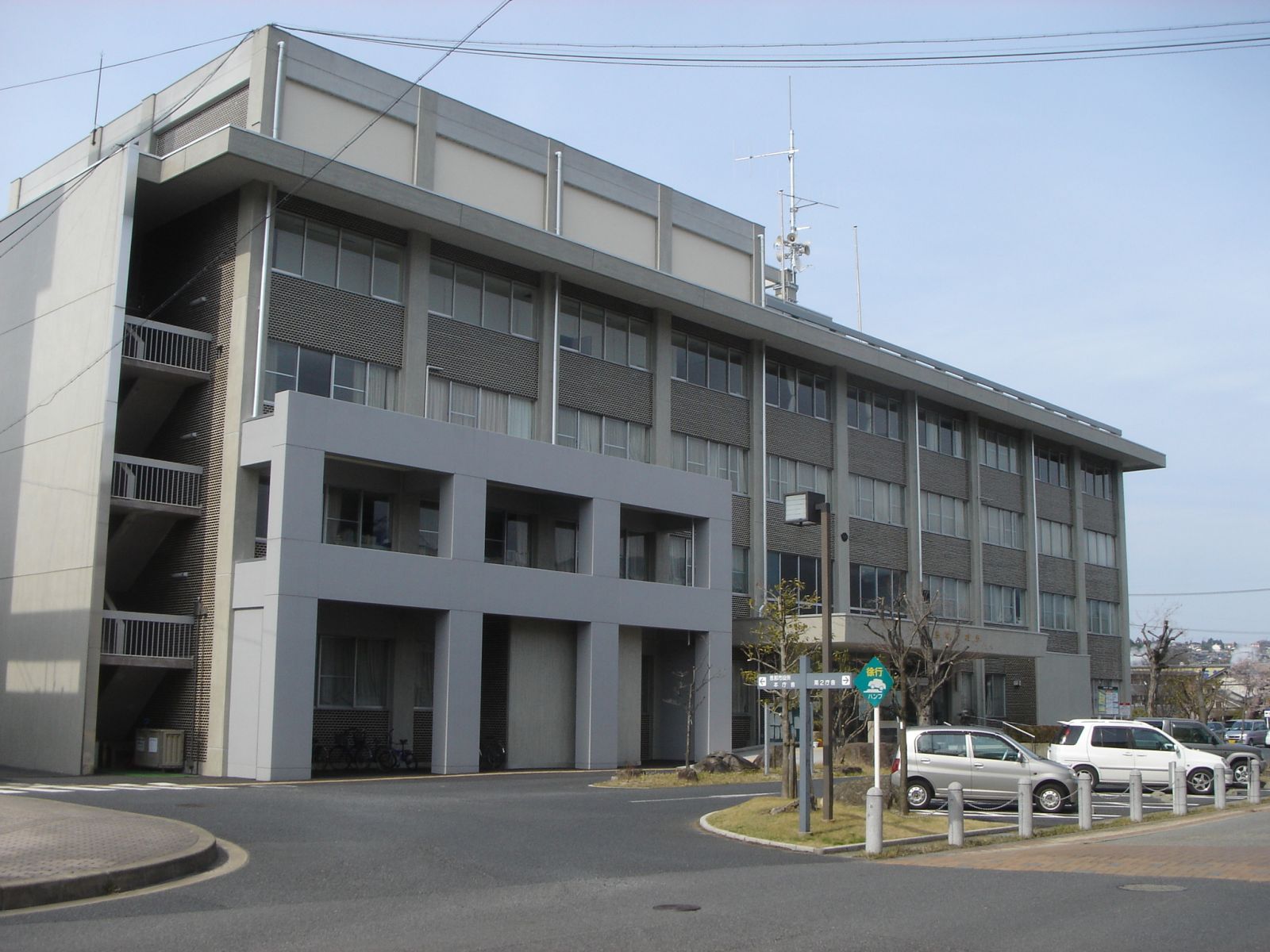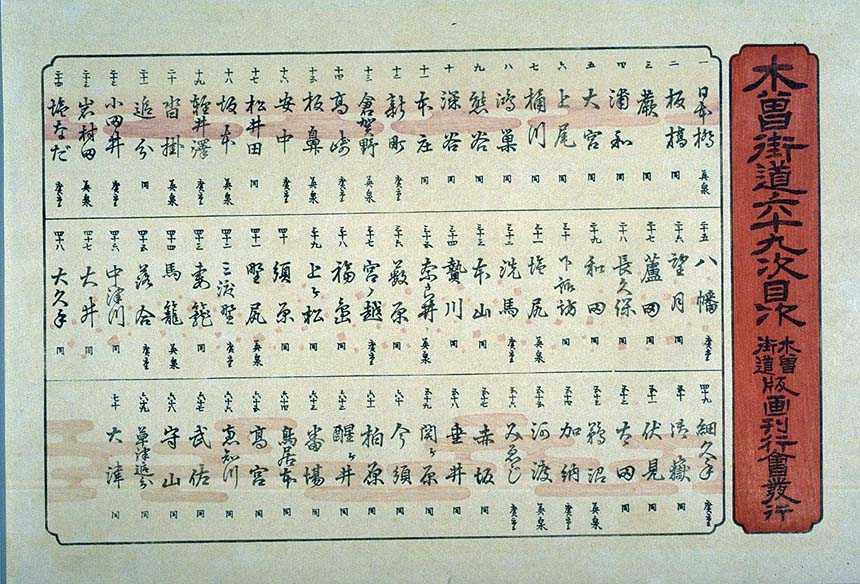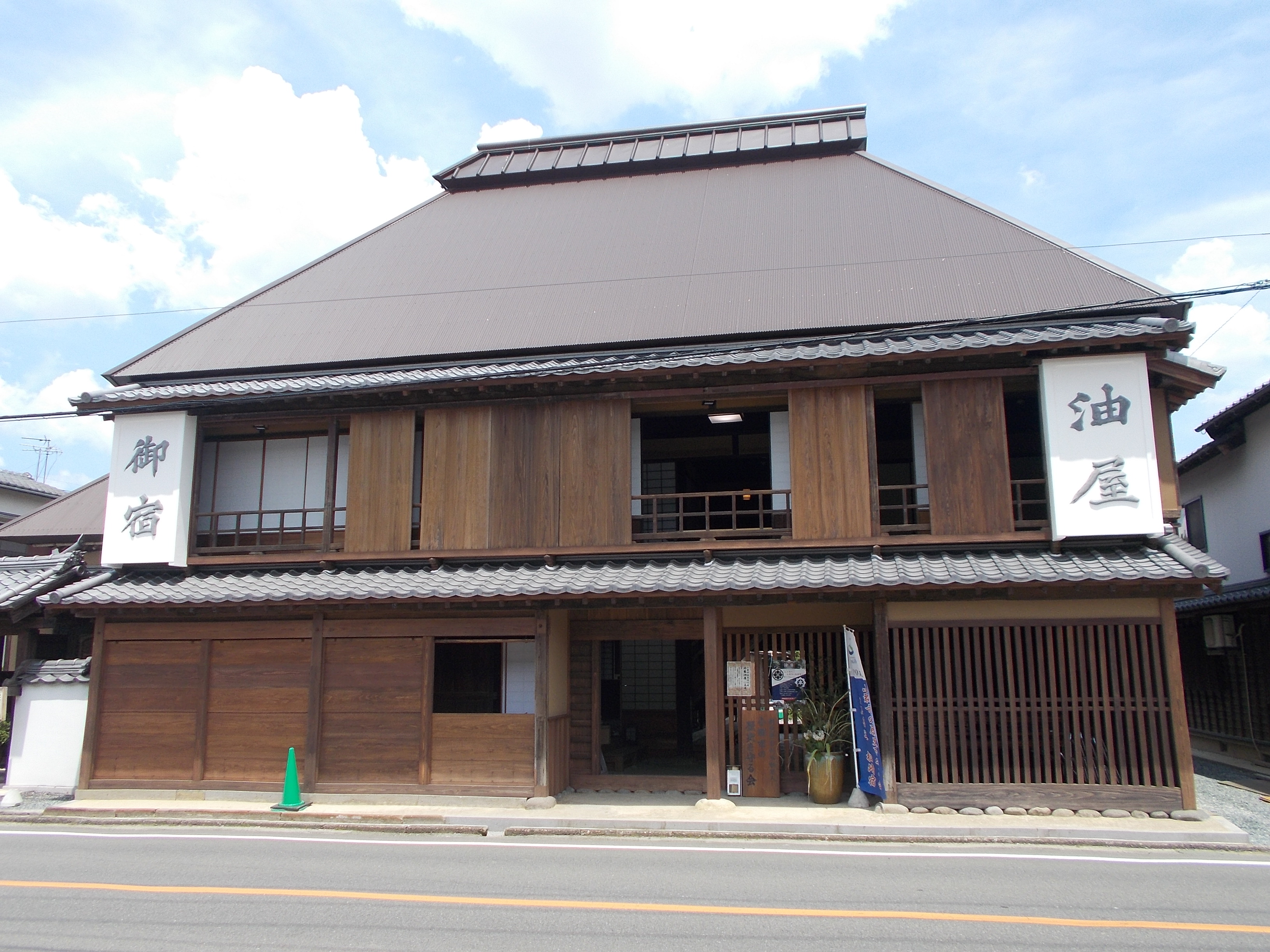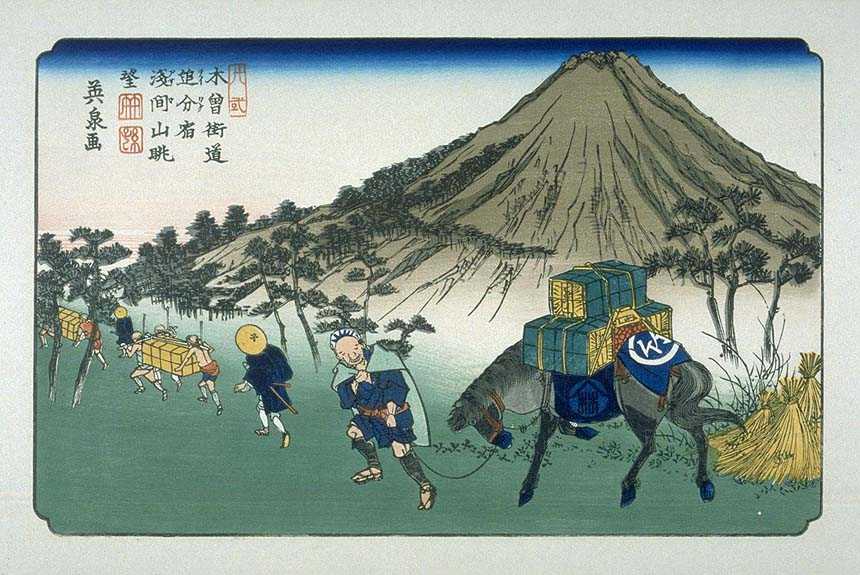|
ŇĆi-juku
was the forty-sixth of the 69 Stations of the NakasendŇć, sixty-nine stations of the NakasendŇć connecting Edo with Kyoto in Edo period Japan. It is located in former Mino Province in what is now part of the city of Ena, Gifu, Ena, Gifu Prefecture, Japan. From ŇĆi-juku to the next post town, ŇĆkute-juku, there are 13 hills to pass over. Travellers using the ShitakaidŇć (šłčŤ°óťĀď) often used ŇĆi-juku, too, as they travelled on to Makiganetsui (śßô„É∂ś†ĻŤŅĹ) afterwards.Nakasendo ŇĆi-juku Ibisoku Co., Ltd. Accessed July 11, 2007. History ŇĆi-juku is located in the southern foothills of the Japanese Alps, near the banks of the Agi River.NakasendŇć ŇĆi ...[...More Info...] [...Related Items...] OR: [Wikipedia] [Google] [Baidu] |
Agi River
The is a river in Japan which flows through Gifu Prefecture. It is part of the Kiso River system. Geography The river originates from Mount Yaki on the border of Nakatsugawa, Gifu, Nakatsugawa and Ena, Gifu, Ena and flows west. It flows through the Akigawa Dam and the ŇĆi Dam before emptying into the Kiso River. History ŇĆi-juku, a post town on the historical NakasendŇć, was on the banks of the Agi River.NakasendŇć ŇĆi-juku . Central Japan Railroad Company. Accessed November 1, 2010. River communities The Agi river flows through the cities of Ena, Gifu, Ena and Nakatsugawa, Gifu, Nakatsugawa in Gifu Prefecture.References Rivers of Gifu Prefecture Rivers of Japan {{Japan-river-stub ...[...More Info...] [...Related Items...] OR: [Wikipedia] [Google] [Baidu] |
Ena, Gifu
is a city located in Gifu, Japan. , the city had an estimated population of 48,777, and a population density of 96.7 persons per km2, in 19,820 households. The total area of the city was . Geography Ena is located in the TŇćnŇć region of southeastern Gifu Prefecture. *Mountains: Mount Kasagi, Mount Hoko, Mount YŇędachi, Mount ByŇćbu, Mount Yake, Mount Mitsumori *Rivers: Kiso River, Agi River, Kamiyahagi River, Kamimura River, Akechi River, Toki River, Ori River *Lakes: Ena Gorge, Lake Hokonoko, Lake Agigawa, Lake Okuyahagi, Lake Origawa Climate The city has a climate characterized by characterized by hot and humid summers, and mild winters (K√∂ppen climate classification ''Cfa''). The average annual temperature in Ena is . The average annual rainfall is with July as the wettest month. The temperatures are highest on average in August, at around , and lowest in January, at around . Neighbouring municipalities *Aichi Prefecture **Toyota *Gifu Prefecture ** Miz ... [...More Info...] [...Related Items...] OR: [Wikipedia] [Google] [Baidu] |
The Sixty-nine Stations Of The Kiso KaidŇć
The or ''Sixty-nine Stations of the Kiso Road'', is a series of ''ukiyo-e'' works created by Utagawa Hiroshige and Keisai Eisen. There are 71 total prints in the series (one for each of the 69 shukuba, post stations and Nihonbashi; Nakatsugawa-juku has two prints). The common name for the KisokaidŇć is "NakasendŇć" so the series is sometimes referred to as the ''Sixty-nine Stations of the NakasendŇć''. It is a follow-up to Hiroshige's ''The Fifty-three Stations of the TŇćkaidŇć'' and he produced 47 of the prints, with Eisen being responsible for the rest.Hiroshige - Kisokaido www.hiroshige.org.uk. Accessed November 1, 2017. The series was published by Iseya Rihei (KinjudŇć) from .Forrer The NakasendŇć The NakasendŇć was one of the Edo Five Routes, Five Routes con ...[...More Info...] [...Related Items...] OR: [Wikipedia] [Google] [Baidu] |
Nakatsugawa-juku
was the forty-fifth of the sixty-nine stations of the NakasendŇć connecting Edo with Kyoto in Edo period Japan. It is located in former Mino Province in what is now part of the city of Nakatsugawa, Gifu Prefecture, Japan.Nakatsugawa-juku . You Yuu Tokai. Accessed July 10, 2007. History Nakatsugawa-juku is located in mountainous terrain, with the Nakatsugawa river, a tributary of the Kiso river flowing by the post station.. In the early , the system of post stations on the NakasendŇ ...[...More Info...] [...Related Items...] OR: [Wikipedia] [Google] [Baidu] |
ŇĆkute-juku
was the forty-seventh of the sixty-nine stations of the NakasendŇć connecting Edo with Kyoto in Edo period Japan. It is located in former Mino Province in what is now part of the city of Mizunami, Gifu Prefecture, Japan. Alternative ''kanji'' for the post town are Ś§ßšĻÖśČč.Nakasendo ŇĆkute-juku Ibisoku Co., Ltd. Accessed July 11, 2007. History ŇĆkute was a settlement on the ancient highway from the , which preceded the construction of the NakasendŇć. Between ŇĆi and ŇĆkute, the road was very narrow and mountainous and goes through 13 passes ( ...[...More Info...] [...Related Items...] OR: [Wikipedia] [Google] [Baidu] |
Shukuba
were Stage station, staging post stations during the Edo period in Japan, generally located on one of the Edo Five Routes or one of its sub-routes. They were also called ''shuku-eki'' (ŚģŅťßÖ). These stage stations, or "" developed around them, were places where travelers could rest on their journey around the nation. They were created based on policies for the transportation of goods by horseback that were developed during the Nara period, Nara and Heian period, Heian periods. History These stations were first established by Tokugawa Ieyasu shortly after the end of the Battle of Sekigahara. The first stations were developed along the TŇćkaidŇć (road), TŇćkaidŇć (followed by stations on the NakasendŇć and other routes). In 1601, the first of the TŇćkaidŇć's 53 Stations of the TŇćkaidŇć, fifty-three stations were developed, stretching from Shinagawa-juku in Edo to ŇĆtsu-juku in ŇĆmi Province. Not all the post stations were built at the same time, however, as the last one was bui ... [...More Info...] [...Related Items...] OR: [Wikipedia] [Google] [Baidu] |
Hatago
were Edo period lodgings for travelers at ''shukuba'' (post stations) along the national highways, including the Edo Five Routes and the subroutes. In addition to a place to rest, ''hatago'' also offered meals and other foods to the travelers. They were also called . Name origin ''Hatago'' means "traveling basket." The word itself originally derived from baskets that contained food for horses and were carried by travelers. From there, it became a tool with which travelers were carry their own food and goods. Shops that began preparing and selling food for travelers gained the suffix , meaning "shop," but this was eventually shortened to just ''hatago''. Preserved ''hatago'' Because many post stations along the TŇćkaidŇć, NakasendŇć The , also called the ,Richard Lane, ''Images from the Floating World'' (1978) Chartwell, Secaucus ; pg. 285 was one of the centrally administered Edo Five Routes, five routes of the Edo period, and one of the two that connected the ''de facto'' ... [...More Info...] [...Related Items...] OR: [Wikipedia] [Google] [Baidu] |
JŇćkamachi
The were centres of the domains of the feudal lords in medieval Japan. The ''jŇćkamachi'' represented the new, concentrated military power of the daimyo in which the formerly decentralized defence resources were concentrated around a single, central citadel. These cities did not necessarily form around castles after the Edo period; some are known as ''jin'yamachi'', cities that have evolved around ''jin'ya'' or government offices that are not intended to provide military services. Defined broadly, ''jokamachi'' includes ''jin'yamachi''. It is also referred to as ''jŇćka'', as was common before the early modern period. History The origins of ''jŇćkamachi'' dates back to the Kamakura period, but it was not until the 1570s in the Sengoku period that the ''jŇćkamachi'' predominated other types of town. The ''jŇćkamachi'' can be divided into the ''shugo jŇćkamachi'', in which a castle town is ruled by the resident daimyo. While the ''shugo jŇćkamachi'' were the political centr ... [...More Info...] [...Related Items...] OR: [Wikipedia] [Google] [Baidu] |
Iwamura Castle
270px, Edo period layout was located in the southeastern area of Mino Province in Japan. Its ruins can be found in the modern-day municipal subdivision of Iwamura, in Ena, Gifu Prefecture. Along with Takatori Castle in Nara and Bitchu-Matsuyama Castle in Okayama, it is regarded as one of the three best mountain castles, and at an elevation of 721 meters above sea level (200 meters above its immediate surroundings), it is one of the highest in Japan. History Iwamura Castle is situated on a steep mountain overlooking the Iwamura Basin. The area commands an intersection of the Sanshu KaidŇć, which connected southern Shinano Province with central Mikawa Province and the Pacific Coast, and the road connecting Mikawa Province with TŇćtŇćmi Province to the east. In the Sengoku period, this area was of great strategic interest to both Takeda Shingen and Oda Nobunaga. During the Kamakura period, eastern Mino was held by Kato Kagekado a vassal of Minamoto no Yoritomo. His descendants fo ... [...More Info...] [...Related Items...] OR: [Wikipedia] [Google] [Baidu] |
Honjin
image:Ohara-juku01s3200.jpg, The ''honjin'' at Inaba KaidŇć's ŇĆhara-shuku. is the Japanese word for an inn for government officials, generally located in post stations (''shukuba'') during the later part of the Edo period. Evolution of ''Honjin'' Originally, ''honjin'' were places from which generals directed battles and, therefore, were fleeting in nature. However, as commanders began to transform the ''honjin'' into temporary lodgings during battle and travel, ''honjin'' came to be places where ''daimyŇć'' and other representatives of the shogunate, including ''hatamoto'', ''monzeki'', etc., were allowed to stay during their travels. Many of the ''honjin'' were actually personal residences of village and town leaders. As such, they received official designations from the government and expanded their residences to include walls, gates and other features. Because of their cooperation, the owners of the ''honjin'' also gained various special rights. General travelers, regardless ... [...More Info...] [...Related Items...] OR: [Wikipedia] [Google] [Baidu] |
Utagawa Hiroshige
or , born AndŇć TokutarŇć (; 1797 ‚Äď 12 October 1858), was a Japanese ''ukiyo-e'' artist, considered the last great master of that tradition. Hiroshige is best known for his horizontal-format landscape series '' The Fifty-three Stations of the TŇćkaidŇć'' and for his vertical-format landscape series '' One Hundred Famous Views of Edo''. The subjects of his work were atypical of the ''ukiyo-e'' genre, whose typical focus was on beautiful women, popular actors, and other scenes of the urban pleasure districts of Japan's Edo period (1603‚Äď1868). The popular series '' Thirty-six Views of Mount Fuji'' by Hokusai was a strong influence on Hiroshige's choice of subject, though Hiroshige's approach was more poetic and ambient than Hokusai's bolder, more formal prints. Subtle use of color was essential in Hiroshige's prints, often printed with multiple impressions in the same area and with extensive use of '' bokashi'' (color gradation), both of which were rather labor-intensive ... [...More Info...] [...Related Items...] OR: [Wikipedia] [Google] [Baidu] |
Machiya
are traditional wooden townhouses found throughout Japan and typified in the historical capital of Kyoto. ('townhouses') and ('farm dwellings') constitute the two categories of Japanese vernacular architecture known as ('folk dwellings'). originated as early as the Heian period and continued to develop through to the Edo period and even into the Meiji period. housed urban merchants and craftsmen, a class collectively referred to as ('townspeople'). The word is written using two kanji: and or , depending on the kanji used to express it. in Kyoto, sometimes called , formed the defining characteristic of downtown Kyoto architecture for centuries,Kyoto Center for Community Collaboration (šļ¨ťÉĹŚłāśôĮŤ¶≥„ÉĽ„Āĺ„Ā°„Ā•„ĀŹ„āä„āĽ„É≥„āŅ„Éľ)(eds.) ''Machiya Revival in Kyoto'' (šļ¨ÁĒļŚģ∂„ĀģŚÜćÁĒü). Kyoto: Kyoto Center for Community Collaboration, 2008. p10. representing the standard defining form of the throughout the country. The typical Kyoto is a long wooden home with ... [...More Info...] [...Related Items...] OR: [Wikipedia] [Google] [Baidu] |






